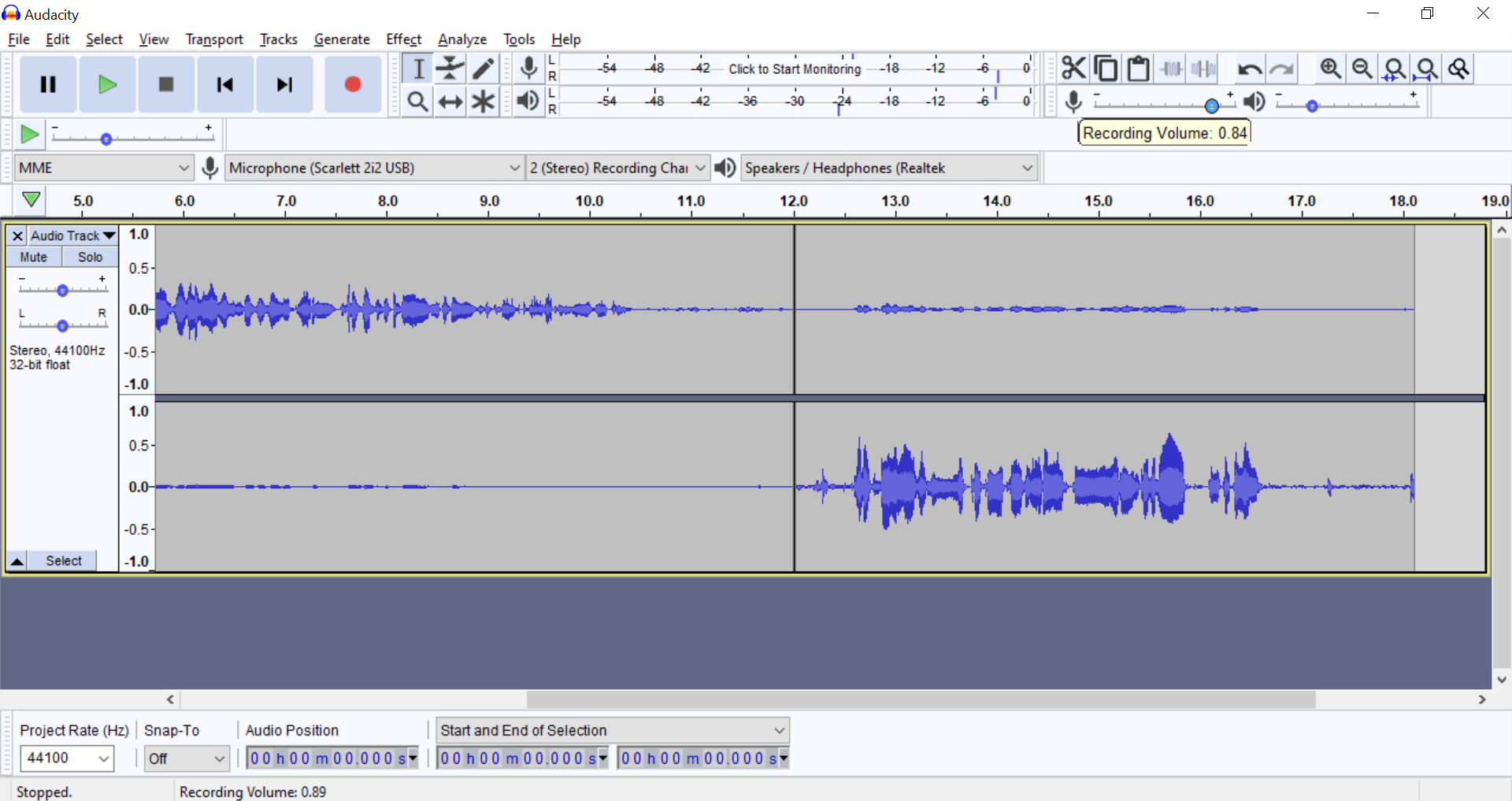| Anchor | ||||
|---|---|---|---|---|
|
...
DAWs are more or less complex, and some include sophisticated post-production tools that can enhance the quality of your recording. But basically any DAW has multiple volume controls, for both microphone input and speaker output. In the example below, you see Audacity running on a Windows 10 laptop. It has a dropdown menu showing the microphone input (in this case a Scarlett 2i2 USB audio interface). In the upper right, there are volume sliders for the microphone gain (currently set to 0.84) and speaker output.
...
Mobile Kits
We have several mobile kit options, of varying complexity. In general, all allow for one- or two-person recording. Some of the kits have two microphones and an interface mobule, together with necessary cables. One of the kits consists solely of a single Blue Yeti microphone.
...
2i2 Second Generation |
One of our mobile podcast kits uses a 2nd generation 2i2, and the other kit uses a 3rd generation 2i2. But for podcasting the 2i2s work the same. The 2i2 do not have a separate power supply, but instead draw power from your laptop, through the USB cable. Plug the USB cable into the back of the 2i2, and your laptop. You will likely want your laptop plugged into AC power. 1. Plug the Microphone XLR cables in to the XLR jacks. 2. Adjust the microphone gain (volume) using these knobs. 3. 4. 5. These are not needed. You can turn or leave them off. 9. Plug the monitor headphones in here. 7. (2nd Gen) or 8. (3rd Gen) Be sure to turn on the monitor headphones. 10. Use this knob to adjust the monitor volume. Even if you haven't done anything with software on your laptop, if the 2i2 is plugged into and drawing power from your PC, you should be able to hear your voice from the microphones, through the monitor headphones. |
2i2 3rd Generation |
User Guides
...
See our Zoom H4N instructions here.
...
Digital Media Laboratory Studio (OM 402)
For podcasts requiring three or four microphones, the COLI Digital Media Laboratory (DML) is available on a limited basis. Please contact the Center for Online Learning & Innovation to discussion possibly using the studio.
...
(click to expand the image)
The DML takes advantage of the Zoom PodTrak P8, a mixer that allows full control of microphone volume and sound effects.
ZoomPodTrak_P8_QuickGuide_2.pdf
ZoomPodtrak_P8_FullOperationManual.pdf
Additional Support and Tutorials
Within the DML, audio is captured through a mixer that sends a single-track USB signal to your laptop-based DAW. So after plugging in the mixer's USB Cable, you should choose the USB Audio CODEC source in your DAW.
...
The mixer allows adjustments to each microphone's sound. When you have a sound setup that is optimal, photograph the mixer with your phone so you can easily reproduce that particular setup.
Reserve the Digital Media Laboratory Podcast Room
...
Not Meeting in Person? Try Zoom!
...
Once you've recorded a podcast or two, setting up will be a quick process. But if you are going to the trouble to record audio, make sure it sounds good!
...
The Finished File: Export as MP3
You use DAWs and the recording hardware to essentially produce one thing: a digital audio file or set of files that has your, and your participants' voices coming through loud and clear. In DAWs such as Audacity and GarageBand, you save a project, not a finished file. That project may combine several files (your voice recording, and perhaps intro music or other audio clips.) You Export the finished file that is the file you upload to the web. An excellent format for this is mp3, which is a good balance of size (compression) and quality.
...
In the above example, the podcast could save the project to disk in a file format specific to Audacity. Instead, he will opt to "Export as MP3," which is a great choice for publishing his podcast episode. Similar to a lot of digital creative work, a project file (or files) are the working files that can be easily modified or edited. These may be a set of audio clips, or contain audio that has been cut out of the track but is still saved in case the podcaster wished to bring them back. Meanwhile, an exported file such as an .mp3 represents the finished audio file, or in this case, podcast episode. Although it could be edited, it is published as a single file and so some editing options are no longer possible. But this file is optimized for upload as a podcast episode.
...
Hosting Podcasts, and Directories
A podcast is a collection of audio files, but to make it available to other people you need to make it available on the web for streaming and download.
...


